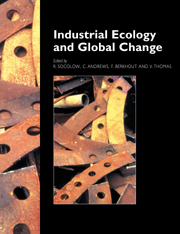Book contents
- Frontmatter
- Contents
- Foreword
- Preface
- Acknowledgments
- Contributors
- OVERVIEW
- PART 1 VULNERABILITY AND ADAPTATION
- 2 Introduction
- 3 Industrial Ecology: Definition and Implementation
- 4 Industrialization as a Historical Phenomenon
- 5 Changing Perceptions of Vulnerability
- 6 The Human Dimension of Vulnerability
- 7 Global Industrialization: A Developing Country Perspective
- PART 2 THE GRAND CYCLES: DISRUPTION AND REPAIR
- PART 3 TOXICS AND THE ENVIRONMENT
- PART 4 INDUSTRIAL ECOLOGY IN FIRMS
- PART 5 INDUSTRIAL ECOLOGY IN POLICY-MAKING
- END PIECE
- Organizing Committee Members
- Working Groups
- Index
4 - Industrialization as a Historical Phenomenon
Published online by Cambridge University Press: 04 August 2010
- Frontmatter
- Contents
- Foreword
- Preface
- Acknowledgments
- Contributors
- OVERVIEW
- PART 1 VULNERABILITY AND ADAPTATION
- 2 Introduction
- 3 Industrial Ecology: Definition and Implementation
- 4 Industrialization as a Historical Phenomenon
- 5 Changing Perceptions of Vulnerability
- 6 The Human Dimension of Vulnerability
- 7 Global Industrialization: A Developing Country Perspective
- PART 2 THE GRAND CYCLES: DISRUPTION AND REPAIR
- PART 3 TOXICS AND THE ENVIRONMENT
- PART 4 INDUSTRIAL ECOLOGY IN FIRMS
- PART 5 INDUSTRIAL ECOLOGY IN POLICY-MAKING
- END PIECE
- Organizing Committee Members
- Working Groups
- Index
Summary
Abstract
Industrialization is described as a historical succession of periods of pervasive adoption of clusters of technological and organizational innovations. Combined they have enabled vastly rising industrial output, productivity, and incomes, as well as reductions in the amount of time worked. The resource and environmental intensiveness of different industrialization paths is illustrated with quantitative data on energy consumption and carbon emissions. It is concluded that industry in principle moves in the right direction of dematerialization and decarbonization; however, to date not fast enough to compensate for increasing output volumes. Continued structural change from industry to services and from work to pleasure will require a redefinition of the scope of industrial activities from artifacts to integrated solutions to satisfy consumer service demands in an environmentally compatible manner.
Introduction
Industrialization is a process of structural change. Sources of productivity and output growth as well as of employment move away from agriculture toward industrial activities, manufacturing in particular (Figures 1 and 2). Rising productivity and output in industry have been main drivers for economic growth and increased national and per capita incomes, which in turn provide an ever enlarging market for industrial products.
Like any pervasive process of economic or social change, industrialization is driven by the diffusion of many individual (but interrelated) innovations.
- Type
- Chapter
- Information
- Industrial Ecology and Global Change , pp. 43 - 68Publisher: Cambridge University PressPrint publication year: 1994
- 12
- Cited by

